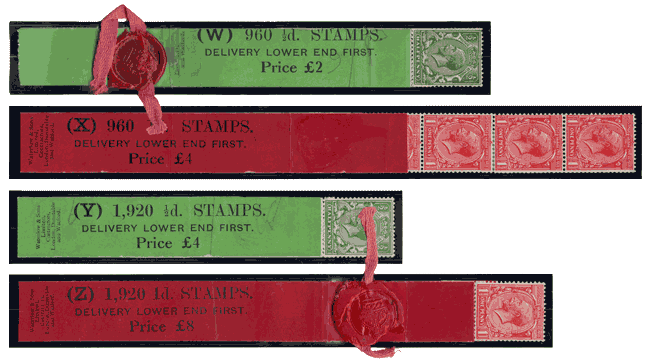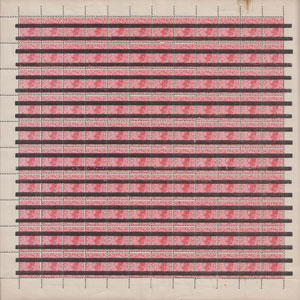
Georgina Elizabeth Kermode was a director of the British Stamp and Ticket Automatic Delivery Co. Ltd. (BSTAD), a company formed in 1907 to market stamp vending machines based on a design by Robert Dickie and John Brown of New Zealand. The Post Office began trials in 1906 which led to the adoption of Kermode machines. Sheets of Australian state of Victoria 1d die II with horizontal bars are said to have been sent to London for these trials.
Click the image to enlarge.
Two vending machines were installed in 1906, one at the House of Commons lobby and the other at Threadneedle Street Branch Office. Both were sideways delivery and sold King Edward VII 1d stamps. In 1907 these machines were modified for endways deliver. By 1911 BSTAD had about a dozen endways delivery machines installed in Post Offices. The company also installed machines in businesses where stamps were sold such as hotels. The first Kermode machines were single units but later became dual ½d and 1d units.
Initially BSTAD made up their own rolls of 1,200 stamps from sheets but, when demand was high, they would also buy Post Office rolls of 1,000 (paying the handling charge) and rewind them to 1,200 stamps. In 1919 BSTAD tried to change over to Post Office (ACJ) rolls, but these were not satisfactory, and BSTAD rewound them, attaching BSTAD leaders with manuscript “1000” and modified roll values.
The BSTAD contract expired in September 1920 and the Post Office took over the machines on their premises which then became the first Post Office owned and operated vending machines. At the same time Harrison was asked to supply Kermode rolls and they did so until until 1924 when the printing contract passed to Waterlow. BSTAD continued to make up rolls for their machines in other businesses.
Mrs Kermode died in 1923 at age 55. BSTAD was taken over by Hall’s Telephone Accessories in 1927. The Kermode name was removed from leaders in 1928.
BSTAD
British Stamp and Ticket Automatic Delivery (BSTAD) leaders were white (or cream) paper printed in green (½d) or red (1d). They showed the roll value, the stamp value, “Prepared By” and “Checked By” initial boxes, and the company’s name & address. They were issued at face value and were for use in any Kermode vending machine.
| BSTAD | ½d | 1,200 | £2.10.0 | Top End | Cream | 10 |
| BSTAD | 1d | 1,200 | £5 | Top End | Cream | 10 |

The 1,000 stamp leaders were as the 1,200 stamp ones, but altered in manuscript. At some point the printed roll value was removed allowing the value to be added by hand. 1d rolls are known uprated from £4.3.4 to £4.3.8, similar to the (A) rolls in use 1920-1924.
| BSTAD | ½d | 1,000 | £2.1.8 | Top End | Cream | 10 |
| BSTAD | 1d | 1,000 | £4.3.4 | Top End | Cream | 10 |
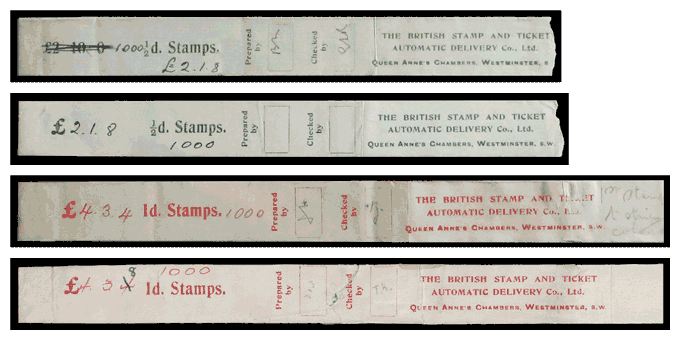
Harrison
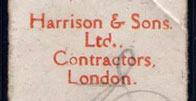
Harrison was asked to supply Kermode rolls when the BSTAD contract expired in September 1920. The leaders were green, red, or white paper and, since they were for use in Post Office vending machines only, they had a restriction clause:

| Kermode | ½d | 1,000 | £2.1.8 | Top End | Green/Buff | 10 |
| Kermode | 1d | 1,000 | £4.3.4 | Top End | Red/Buff | 10 |
| Kermode | 2d | 1,000 | £8.6.8 | Top End | White | 10 |
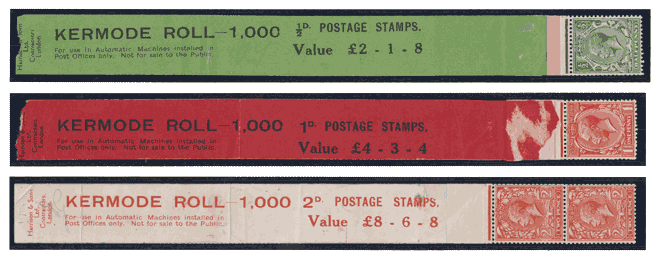
The minimum Inland Letter Rate was reduced from 2d back to 1½d on 29 May 1922. This did not cause any change in roll production but did reduce the demand for 2d rolls (and for the experimental 3s booklets with 18 x 2d stamps). Unsold (QRT) rolls were returned to the Post Office Stores and held in stock, unsold booklets were destroyed, and unsold 2d Kermode rolls were issued to Postmasters for over the counter sales.
Waterlow
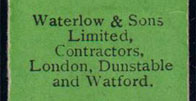
The printing contract changed from Harrison to Waterlow in 1924. At the same time, the watermark was changed from Royal Cypher to Block Cypher. Waterlow was to print rolls by the continuous letterpress process established at Somerset House and Kermode rolls would now have either 960 or 1,920 stamps.
Waterlow rolls have the same restrictions clause but the font has serifs and is slightly smaller. The right side of the clause is short of the last L in ROLL. Some Waterlow rolls have a variety with “Sale” capitalised (illustrated). This is uncommon, possibly only one roll in 12, but occurs on both ½d and 1d leaders:

| Kermode | ½d | 960 | £2.0.0 | Top End | Green/Buff | c |
| Kermode | 1d | 960 | £4.0.0 | Top End | Red/Buff | c |
| Kermode | ½d | 1,920 | £4.0.0 | Top End | Green/Buff | c |
| Kermode | 1d | 1,920 | £8.0.0 | Top End | Red/Buff | c |
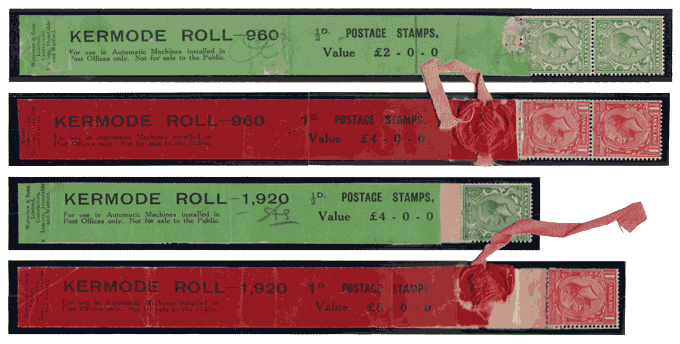
Waterlow also produced some 1d rolls of 1,000 stamps. These were later changed to 960 stamps by covering the original size and price with a coloured label.
| Kermode | 1d | 1,000 | £4.3.4 | Top End | Red/Buff | c |
| Kermode | 1d | 960 | £4.0.0 | Top End | Red/Buff | c |
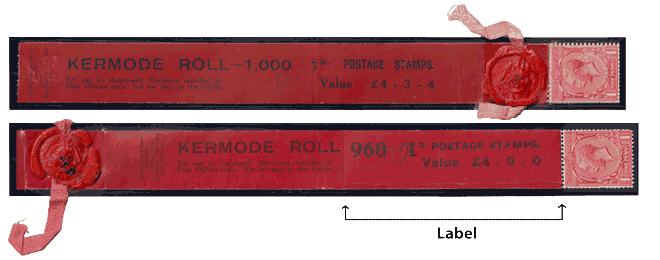
Change of Delivery
Some complaints were made by Postmasters in 1927 that, since Kermode rolls were delivered top end first, stamps were often applied upside down. As no reason was known why they were this way, it was agreed to change to lower end delivery, and Waterlow was directed to do so in November.
| Kermode | ½d | 960 | £2.0.0 | Lower End | Green/Buff | c |
| Kermode | 1d | 960 | £4.0.0 | Lower End | Red/Buff | c |
| Kermode | ½d | 1,920 | £4.0.0 | Lower End | Green/Buff | c |
| Kermode | 1d | 1,920 | £8.0.0 | Lower End | Red/Buff | c |
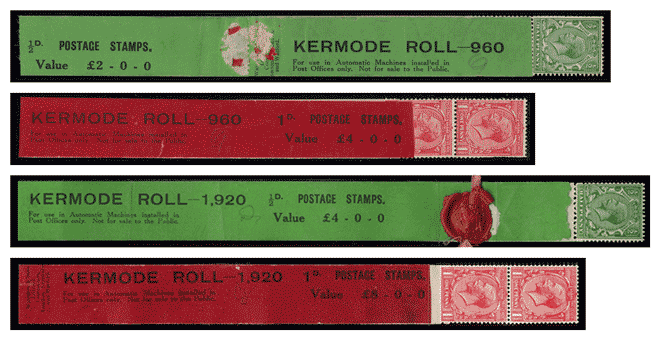
Change of Name
Removal of the Kermode name was suggested in October 1927 after BSTAD had been taken over by Hall’s Telephone Accessories. Waterlow had enough leaders in stock to last about a year, and in October 1928 they were instructed to use letter codes (WXYZ) instead.
| W | ½d | 960 | £2.0.0 | Lower End | Green/Buff | c |
| X | 1d | 960 | £4.0.0 | Lower End | Red/Buff | c |
| Y | ½d | 1,920 | £4.0.0 | Lower End | Green/Buff | c |
| Z | 1d | 1,920 | £8.0.0 | Lower End | Red/Buff | c |
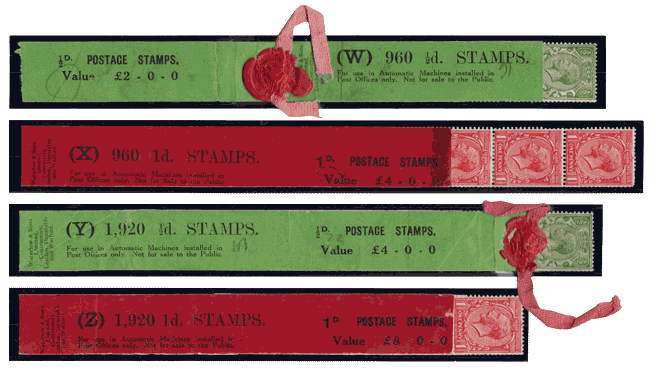
The Post Office announced in November 1930 that (WXYZ) rolls were no longer restricted to use in Post Offices and could be sold to the public. The restriction clause was blanked out with a thick black line.
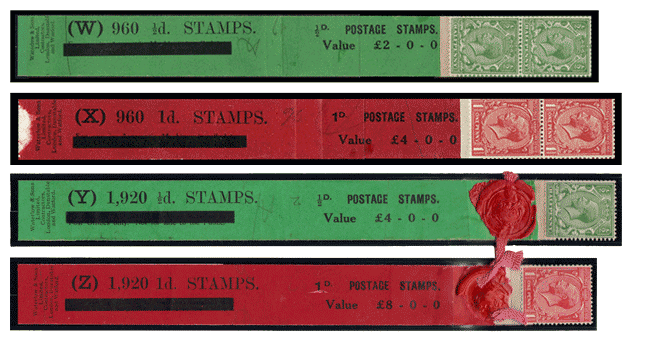
As stocks of the restricted leaders were exhausted, new leaders were printed without the clause.
